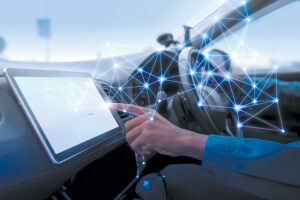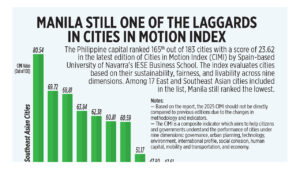Trailblazers of technology in motion

In the current buzz surrounding generative artificial intelligence (AI), it’s easy to overlook one of AI’s earliest and most practical frontiers: the automotive industry.
Long before ChatGPT or image generators captured mainstream attention, automakers were already integrating AI in subtle, sophisticated methods under Advanced Driver Assistance Systems (ADAS) — otherwise known as the everyday conveniences in modern automobiles such as adaptive cruise control, lane-keeping assistance, automatic emergency brakes, and self-parking systems.
While these technologies were not ‘intelligent’ in the way people imagine AI to be, they functioned on similar logical, rules-based systems that established the groundwork for more contemporary iterations.
For instance, adaptive cruise control systems utilize radar sensors to automatically adjust a car’s speed to maintain a safe distance from other vehicles on the road. Automatic emergency brakes functioned the same way. Lane keeping assistance systems, meanwhile, used real-time image processing to detect important road signs and help prevent unintentional lane departures or even provide steering input to keep the vehicle centered.
Building on that foundation has opened the door to countless possibilities in the industry, such as: autonomous vehicles using cutting-edge sensor technology to perceive and understand their surroundings; AI-driven predictive maintenance using the data from those same sensors to determine when components are likely to fail, allowing for proactive maintenance; real-time navigation assistants powered by personalized driver profiles and satellite imagery; and much more.
Automakers are already investing massively to bring such visions to life. Just last March, American automotive brand General Motors signed a partnership with technology firm NVIDIA to use artificial intelligence chips and software to develop autonomous vehicle technology for its vehicles and improve workflow at its factories.
According to the two companies, the plan is to cooperate in creating AI systems founded on NVIDIA’s platforms suited for factory planning and for future advanced driver-assistance systems.
The news follows similar agreements made by NVIDIA with Japanese car maker Toyota and the Korean Hyundai to collaborate in the development of autonomous driving systems. Other mobility companies are also working with the technology firm for its advanced driver-assistance systems and autonomous vehicle roadmaps include BYD, JLR, Li Auto, Lucid, Mercedes-Benz, NIO, Nuro, Rivian, Volvo Cars, Waabi, Wayve, Xiaomi, ZEEKR, and Zoox.
“The autonomous vehicle revolution has arrived, and automotive will be one of the largest AI and robotics industries,” Jensen Huang, founder and CEO of NVIDIA, said in a statement. “NVIDIA is bringing two decades of automotive computing, safety expertise and its CUDA AV platform to transform the multitrillion dollar auto industry.”
Notably, Wayve, the autonomous driving startup based in London, is fast-tracking its global expansion, leading the development of autonomous automobiles in Europe. The company, one of the highest profile AI companies in the continent, has recently established an office in Germany, with further plans to expand across the EU.
The progress of technology is also opening the doors to other opportunities in the automotive space. At the CES 2025, brands have showcased how new technologies are driving the development of electric vehicles and improving user experiences through features like personalized software features and interactive AI systems.
Among these was the breakthrough collaboration between semiconductor firm Omnivision and healthcare technology firm Philips. The two brands unveiled the world’s first in-cabin connected well-being monitoring solution, which smartly tracks vital signs to increase passenger comfort by adjusting lighting and climate and suggesting breaks or route changes.
Automotive parts manufacturing company Continental AG unveiled a biometric sensing display that discreetly monitors vital signs using a hidden camera and a laser projector installed behind the dashboard display to support a wide range of safety and comfort functions.
Garmin, a prominent GPS and automotive technology provider, demonstrated the benefits of intelligent system integration at the annual trade show with its new domain controller, a single module that streamlines the management of six in-vehicle displays, and supports safety features like child detection and driver monitoring alongside entertainment.
Meanwhile, Hyundai Mobis also showcased new innovations with a full-windshield holographic display designed to project essential information for the driver and assist with decision-making on the road.
Honda and Sony Honda Mobility unveiled the results of their collaboration, the Afeela 1, featuring an interactive AI voice agent alongside plans for accelerating EV adoption by building 100,000 EV charging stations by 2030.
“Sony Honda Mobility strives to evolve relationships with people through intelligent mobility and revolutionize the travel experience,” Yasuhide Mizuno, chairperson and CEO of Sony Honda Mobility, was quoted as saying at the annual technology show. “We are very pleased to unveil Afeela 1, developed for the era of autonomous driving, at CES 2025. Afeela 1 can be called a buddy, combining advanced software with meticulously refined hardware.”
It is clear that the automotive industry is fully living up to its history as the pioneers of the practical implementation of new technology. “Away from the usual CES razzmatazz we saw a number of trends emerge that will continue to shape the future of mobility. This year’s CES was a testament to the industry’s shift towards practical, executable solutions while keeping an eye on the future,” Brian Rhodes, director at S&P Global Mobility, wrote about CES 2025.
“AI was omnipresent, from practical applications to those where use cases are perplexing. SDVs took center stage, with the ecosystem rallying around them. The focus was on execution, with futuristic concepts taking a backseat for now. Autonomous vehicles made a strong impression, moving from mere hype to near-term reality.” — Bjorn Biel M. Beltran




